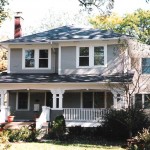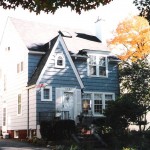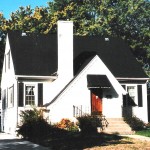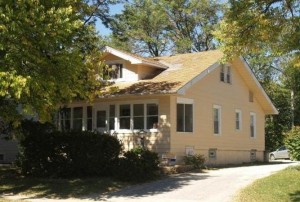If you live in Field Park, Old Town, Old Town South, or Ridge Acres, the rafters and joists in your home (or that of a neighbor) might have numbers like this imprinted on them. And, if so, they can tell an interesting story.

Americus: 4033 Grove

Brookwood: 4237 Garden

Maplewood: 4330 Western

Rembrandt: 4034 Lawn
Between 1908 and 1940, both Sears Roebuck and Montgomery Ward offered prefabricated homes for sale through their mail-order catalogs. An estimated 100,000 such homes were built across America until World War II intervened. By all accounts, the homes were extremely well designed and many are still in use. In fact, they have become very sought after by preservationists.
The 1908 Sears catalog offered 44 house styles, ranging in price from $495 to $4,115. According to one account, the average Sears home would arrive in two railroad boxcars and consist of some 30,000 pieces. A 75-page, leather-bound book of construction details would accompany the shipment. Sears promised that a person of average abilities could build the house, but advised that a local carpenter could be hired for about $450 to assemble it. In 2012 dollars, that would be equivalent to $11,250.

Catalog Home Locations
Determining whether a home is a “mail-order” house is not always easy. That’s because there were an estimated 450 styles or designs offered over the years. In addition, manufacturers and local carpenters often modified the designs to suit the buyer. And, after 80 or more years, most of these homes have been updated with new siding, windows, room additions, etc.
Identifying a catalog home is best accomplished from the inside, not outside. Every piece of lumber was stamped with a letter and a two- or three-digit number. So, if a homeowner goes into their basement or attic with a flashlight, they can usually determine whether it is a “mail-order home”.
Illinois is thought to have the largest number of such homes, due in part to the low cost of shipping from Sears’ and Wards’ Chicago warehouses, as well as the state’s abundance of railroad lines.
But, where are the catalog homes in Western Springs?

818 47th Street
All are believed to be north of 47th Street. This is because the early developers of Forest Hills established a minimum price for new homes that effectively precluded their construction. And, other areas south of 47th Street were not yet being developed. While there is no definitive list of Sears and Wards homes that were built in our village, at least 14 have been identified, along with another three “possibles” (green dots).
According to the Western Springs Historical Society archives, one person with especially fond memories of a Sears home was Ernest Bollow, whose father built their family home at 818-47th Street.
Although now deceased, in 1986 Ernest took the time to write a letter to the Historical Society describing how his father, Henry, had ordered their Sears home, started construction in 1924, and moved the family into the house in early 1925. While he couldn’t recall the exact price of the house (probably less than $4,000), he recalled that his father bought the lot for a mere $200.
